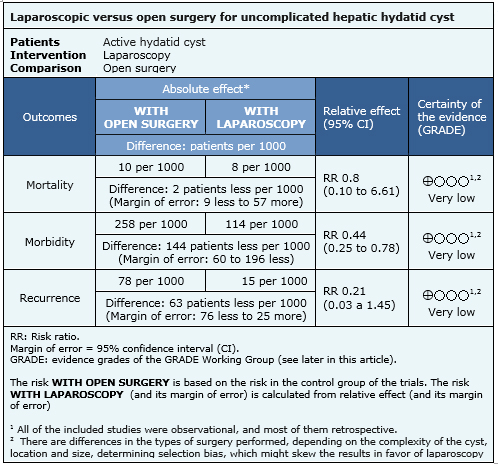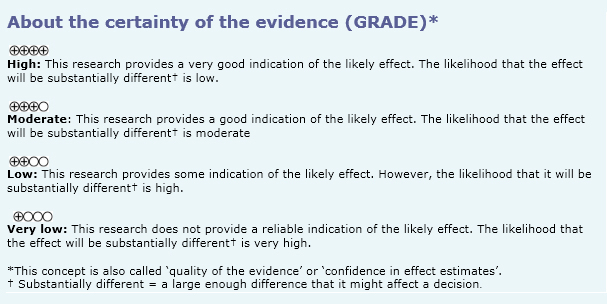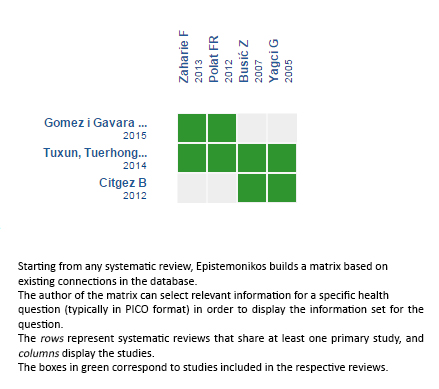 Para Descargar PDF debe Abrir sesión.
Para Descargar PDF debe Abrir sesión.
The laparoscopic approach has taken a prominent role in the last decades for various surgical conditions, including liver hydatid cyst. However there is controversy about whether it can replace open surgery. Using Epistemonikos database, which is maintained by screening 30 databases, we identified three systematic reviews which together include four relevant studies, all nonrandomized. We combined the evidence using meta-analysis and generated a summary of findings table following the GRADE approach. We concluded it is unclear whether laparoscopy for hepatic hydatid cyst reduces mortality, morbidity or recurrence compared with open surgery because the certainty of the evidence is very low.
Hydatid cyst or hydatid disease is a zoonosis caused by Echinococcus granulosus. It is widely spread throughout the world, with endemic areas in the Mediterranean, South America, New Zealand, Australia, among others [1]. It may compromise multiple organs, but the most commonly affected is the liver. There are various treatments, from medical management with anthelmintics to more aggressive treatments such as surgery, which is currently considered as standard of treatment [2]. This can be done by radical surgery (hepatectomy or pericystectomy) or conservative (cystectomy, deroofing, omentoplasty, among others). Radical surgery has shown the lowest long-term risk of recurrence [2].
With the development of minimally invasive techniques, laparoscopic approach has taken a prominent role in various surgical conditions, including hepatic hydatid disease.
We used Epistemonikos database, which is maintained by screening more than 30 databases, to identify systematic reviews and their included primary studies. With this information we generated a structured summary using a pre-established format, which includes key messages, a summary of the body of evidence (presented as an evidence matrix in Epistemonikos), meta-analysis of the total of studies, a summary of findings table following the GRADE approach and a table of other considerations for decision-making.
|
Key messages
|
|
What is the evidence. |
We found three systematic reviews [2],[3],[4], which include four studies relevant to our question, none of them randomized. Three were retrospective [6],[7],[8] and one prospective [5]. |
|
What types of patients were included |
The studies included patients older than 10 years with active liver hydatid cyst (cysts type I to IV or CE1 to CE4). One study [8] excluded patients with cysts located in segment 1 and 7 and with evidence of intrabiliary rupture. None of the studies included emergency surgery for complicated cyst. |
|
What types of interventions were included |
All studies compared laparoscopy versus open surgery [5],[6],[7],[8]. Regarding the different types of surgery, studies divided it into conservative surgery where only the membrane was removed and pericystic parasite remained in the liver, and radical procedures including pericystectomy and liver resection. Two studies [6],[8] included only conservative laparoscopic management in the laparoscopy group, and one study [8] did not include radical surgery in the open surgery group. |
|
What types of outcomes |
Perioperative mortality and morbidity, relapse and hospital stay were compared across studies included in the summary. They also measured general complications such as fever of unknown origin, subcutaneous hematoma, pleural effusion or empyema, pneumonia, atelectasis, drug induced fever and hyperosmolar coma. |
The information on the effects of laparoscopic hepatic hydatid disease management is based on one prospective and three retrospectives studies including 486 patients. All studies reported the outcomes mortality, perioperative morbidity and recurrence.


|
To whom this evidence does and does not apply |
|
| About the outcomes included in this summary |
|
| Balance between benefits and risks, and certainty of the evidence |
|
| What would patients and their doctors think about this intervention |
|
| Resource considerations |
|
|
Differences between this summary and other sources |
|
| Could this evidence change in the future? |
|
Using automated and collaborative means, we compiled all the relevant evidence for the question of interest and we present it as a matrix of evidence.

Follow the link to access the interactive version: Laparoscopic versus open surgery for liver cystic echinococcosis
The upper portion of the matrix of evidence will display a warning of “new evidence” if new systematic reviews are published after the publication of this summary. Even though the project considers the periodical update of these summaries, users are invited to comment in Medwave or to contact the authors through email if they find new evidence and the summary should be updated earlier. After creating an account in Epistemonikos, users will be able to save the matrixes and to receive automated notifications any time new evidence potentially relevant for the question appears.
The details about the methods used to produce these summaries are described here http://dx.doi.org/10.5867/medwave.2014.06.5997.
Epistemonikos foundation is a non-for-profit organization aiming to bring information closer to health decision-makers with technology. Its main development is Epistemonikos database (www.epistemonikos.org).
These summaries follow a rigorous process of internal peer review.
Conflicts of interest
The authors do not have relevant interests to declare.
 Esta obra de Medwave está bajo una licencia Creative Commons Atribución-NoComercial 3.0 Unported. Esta licencia permite el uso, distribución y reproducción del artículo en cualquier medio, siempre y cuando se otorgue el crédito correspondiente al autor del artículo y al medio en que se publica, en este caso, Medwave.
Esta obra de Medwave está bajo una licencia Creative Commons Atribución-NoComercial 3.0 Unported. Esta licencia permite el uso, distribución y reproducción del artículo en cualquier medio, siempre y cuando se otorgue el crédito correspondiente al autor del artículo y al medio en que se publica, en este caso, Medwave.

The laparoscopic approach has taken a prominent role in the last decades for various surgical conditions, including liver hydatid cyst. However there is controversy about whether it can replace open surgery. Using Epistemonikos database, which is maintained by screening 30 databases, we identified three systematic reviews which together include four relevant studies, all nonrandomized. We combined the evidence using meta-analysis and generated a summary of findings table following the GRADE approach. We concluded it is unclear whether laparoscopy for hepatic hydatid cyst reduces mortality, morbidity or recurrence compared with open surgery because the certainty of the evidence is very low.
 Autores:
Vanessa Ahumada[1,2], Felipe Moraga[1,2], Gabriel Rada[1,2,3,4,5]
Autores:
Vanessa Ahumada[1,2], Felipe Moraga[1,2], Gabriel Rada[1,2,3,4,5]

Citación: Ahumada V, Moraga F, Rada G. Laparoscopy or open surgery for the treatment of hydatid cyst?. Medwave 2016;16(Suppl 1):e6385 doi: 10.5867/medwave.2016.6385
Fecha de publicación: 22/3/2016

Nos complace que usted tenga interés en comentar uno de nuestros artículos. Su comentario será publicado inmediatamente. No obstante, Medwave se reserva el derecho a eliminarlo posteriormente si la dirección editorial considera que su comentario es: ofensivo en algún sentido, irrelevante, trivial, contiene errores de lenguaje, contiene arengas políticas, obedece a fines comerciales, contiene datos de alguna persona en particular, o sugiere cambios en el manejo de pacientes que no hayan sido publicados previamente en alguna revista con revisión por pares.
Aún no hay comentarios en este artículo.
Para comentar debe iniciar sesión
 Medwave publica las vistas HTML y descargas PDF por artículo, junto con otras métricas de redes sociales.
Medwave publica las vistas HTML y descargas PDF por artículo, junto con otras métricas de redes sociales.
 Nunnari G, Pinzone MR, Gruttadauria S, Celesia BM, Madeddu G, Malaguarnera G, et al. Hepatic echinococcosis: clinical and therapeutic aspects. World J Gastroenterol. 2012 Apr 7;18(13):1448-58. | CrossRef | PubMed |
Nunnari G, Pinzone MR, Gruttadauria S, Celesia BM, Madeddu G, Malaguarnera G, et al. Hepatic echinococcosis: clinical and therapeutic aspects. World J Gastroenterol. 2012 Apr 7;18(13):1448-58. | CrossRef | PubMed | Gomez I Gavara C, López-Andújar R, Belda Ibáñez T, Ramia Ángel JM, Moya Herraiz Á, et al. Review of the treatment of liver hydatid cysts. World J Gastroenterol. 2015 Jan 7;21(1):124-31. | CrossRef | PubMed |
Gomez I Gavara C, López-Andújar R, Belda Ibáñez T, Ramia Ángel JM, Moya Herraiz Á, et al. Review of the treatment of liver hydatid cysts. World J Gastroenterol. 2015 Jan 7;21(1):124-31. | CrossRef | PubMed | Tuxun T, Zhang JH, Zhao JM, Tai QW, Abudurexti M, Ma HZ, et al. World review of laparoscopic treatment of liver cystic echinococcosis--914 patients. Int J Infect Dis. 2014 Jul;24:43-50. | CrossRef | PubMed |
Tuxun T, Zhang JH, Zhao JM, Tai QW, Abudurexti M, Ma HZ, et al. World review of laparoscopic treatment of liver cystic echinococcosis--914 patients. Int J Infect Dis. 2014 Jul;24:43-50. | CrossRef | PubMed | Citgez B, Battal M, Cipe G, Karatepe O, Muslumanoglu M. Feasibility and safety of laparoscopic hydatid surgery: a systematic review. Hepatogastroenterology. 2013 Jun;60(124):784-8. | PubMed |
Citgez B, Battal M, Cipe G, Karatepe O, Muslumanoglu M. Feasibility and safety of laparoscopic hydatid surgery: a systematic review. Hepatogastroenterology. 2013 Jun;60(124):784-8. | PubMed | Busić Z, Lemac D, Stipancić I, Busić V, Cavka M, Martić K. Surgical treatment of liver echinococcosis--the role of laparoscopy. Acta Chir Belg. 2006 Nov-Dec;106(6):688-91. | PubMed |
Busić Z, Lemac D, Stipancić I, Busić V, Cavka M, Martić K. Surgical treatment of liver echinococcosis--the role of laparoscopy. Acta Chir Belg. 2006 Nov-Dec;106(6):688-91. | PubMed | Yagci G, Ustunsoz B, Kaymakcioglu N, Bozlar U, Gorgulu S, Simsek A, et al. Results of surgical, laparoscopic, and percutaneous treatment for hydatid disease of the liver: 10 years experience with 355 patients. World J Surg. 2005 Dec;29(12):1670-9. | PubMed |
Yagci G, Ustunsoz B, Kaymakcioglu N, Bozlar U, Gorgulu S, Simsek A, et al. Results of surgical, laparoscopic, and percutaneous treatment for hydatid disease of the liver: 10 years experience with 355 patients. World J Surg. 2005 Dec;29(12):1670-9. | PubMed | Zaharie F, Bartos D, Mocan L, Zaharie R, Iancu C, Tomus C. Open or laparoscopic treatment for hydatid disease of the liver? A 10-year single-institution experience. Surg Endosc. 2013 Jun;27(6):2110-6. | CrossRef | PubMed |
Zaharie F, Bartos D, Mocan L, Zaharie R, Iancu C, Tomus C. Open or laparoscopic treatment for hydatid disease of the liver? A 10-year single-institution experience. Surg Endosc. 2013 Jun;27(6):2110-6. | CrossRef | PubMed |